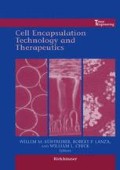Abstract
With the creation of artificial organ technology, the concept of replacement of failed natural organs has shifted focus from mere life-saving objectives to a broader goal to fulfill quality of life expectations. The kidney was the first solid organ whose function was approximated by a man-made synthetic device and also the first organ replaced by autologous transplantation on a long-term basis. Current organ substitution techniques for end stage renal disease (ESRD) involve either transplanting human kidneys or attempting substitution for functions of diseased kidneys through dialysis. Despite encouraging and improving results from organ transplantation, the preferred choice of substitution therapy, it is still hampered by a shortage of organs, chronic transplant loss, and a changed patient population (Hillebrand and Land 1996). Dialysis therapy only partially replaces the filtration component of renal function and is still an imperfect, intermittent, expensive, and time-consuming replacement of renal function. Dialysis also indiscriminately removes solutes, fails to substitute for renal hormonal and metabolic activities, and requires dietary restrictions and drug therapy to maintain the patient in a state of suboptimal health. The kidney is not simply a filter that produces urine as a waste product, but by monitoring and adjusting the concentrations of multiple compounds in the blood within very narrow limits, it regulates the internal environment to maintain near-perfect homeostasis. The realization that the complexity and amazing efficiency of the natural kidneys cannot be easily mimicked by man-made materials motivates work towards providing a biological component to the artificial kidney device. Hybridization, which means the combining of biological tissues with artificial hardware, is the most plausible solution to constructing “near-natural” kidneys. When such a neoartificial kidney is implanted, it will allow a continuous, increased level of filtration and will also replace the metabolic and endocrine functions “naturally.” This approach may circumvent the shortage problem posed by renal transplantations.
Access this chapter
Tax calculation will be finalised at checkout
Purchases are for personal use only
Preview
Unable to display preview. Download preview PDF.
References
Baldamus CA, Pollok M. 1989. Ultrafiltration and hemofiltration, practical applications in replacement of renal function by dialysis. In: Maher J, editor. 3rd ed. Boston: Kluwer Academic Publishers.
Brenner BM, Hostetter TH, Humes HD. 1978. Molecular basis of proteinuria of glomerular origin. New England Journal of Medicine 298(15):826–833.
Coimbra TM, Cieslinski DA, Humes HD. 1990. Epidermal growth factor accelerates renal repair in mercuric chloride nephrotoxicity. American Journal of Physiology 259:F438–F443.
Golper TA. 1985. Continuous arteriovenous hemofiltration in acute renal failure. American Journal of Kidney Diseases 6(6):373–386.
Guyton AC, Hall JE. 1997. Human physiology and mechanisms of disease. 6th ed. Philadelphia W.B. Saunders Company, p 212–230.
Hillebrand G, Land W. 1996. Renal transplantation: progress and prospects. Artificial Organs 20(5):403–407.
Humes HD, Cieslinski DA, Coimbra TM. 1989. Epidermal growth factor enhances renal tubule cell regeneration and repair and accelerates the recovery of renal function in postischemic acute renal failure. Journal of Clinical Investigation 84(6): 1757–1761.
Humes HD, Cieslinski DA. 1992. Interaction between growth factors and retinoic acid in the induction of kidney tubulogenesis in tissue culture. Experimental Cell Research 201(1):8–1
Humes HD. 1995. Tissue engineering of the kidney. In: Bronzino JD, editor. The biomedical engineering handbook. Boca Raton: CRC Press, p 1807–1824.
Humes HD. 1996. Application of gene and cell therapies in the tissue engineering of a bioartificial kidney (editorial). Int J Artif Organs 19(4):215–217.
Humes HD. 1996. The bioartificial renal tubule: Prospects to improve supportive care in acute renal failure. Ren Fail 18(3):405–408.
Humes HD. 1996. Tissue engineering of a bioartificial kidney: A universal donor organ. Transplant Proc 28(4):2032–2035.
Humes HD, Krauss JC, Cieslinski DA. 1996. Tubulogenesis from isolated single cells of adult mammalian kidney: Clonal analysis with a recombinant retrovirus. American Journal of Physiology 271: F42–F49.
Kramer P, Wigger W, Rieger J. 1977. Arterio-venous hemofiltration: a new and simple method for treatment of overhydrated patients resistant to diuretics. Klin Wochenschr 55:1121.
Kadletz M, Magometschnigg H, Minar, E. 1992. Implantation of in vitro endothelialized polytetrafluoroethylene grafts in human beings. J Thorac Cardiovasc Surg 104:736.
Mackay S, Funke A, Buffington D, Humes HD. 1998. Tissue engineering of bioartificial renal tubule. ASAIO: 44:179–183.
Matsumura KN. 1978. After fifteen years: artificial liver & artificial pancreas. 2nd ed. Berkeley, CA: Alin Foundation Press.
Robertson CR, Deen WM, Troy JL, Brenner BM. 1972. Dynamics of glomerular ultrafiltration in the rat. 3. Hemodynamics and autoregulation. Am J Physiol 223(5): 1191–1200.
Shepard AD, Eldrup-Jorgensen J, Keough EM. 1986. Endothelial cell seeding of small-caliber synthetic grafts in the baboon. Surgery 99:318.
Schnider PA, Hanson SR, Price TM. 1988. Durability of confluent endothelial cell monolayers of small-caliber vascular prostheses in vitro. Surgery 103:456.
United States Renal Data System 1994 annual data report. Prevalence and cost of ESRD therapy. American Journal of Kidney Diseases 18(5)(supp 2):21.
Wilson JM, Birinyl LK, Salomon RN. 1989. Implantation of vascular grafts lined with genetically modified endothelial cells. Science 244(4910): 1344–1346.
Woods JD, Humes HD. 1997. Prospects for a bioartificial kidney. Seminars in Nephrology 17:1–6.
Zwiebel JA, Freeman SM. Kantoff PW. 1989. Highlevel recombinant gene expression rabbit endothelial cells transduced by retroviral vectors. Science 243(4888):220–222.
Editor information
Editors and Affiliations
Rights and permissions
Copyright information
© 1999 Springer Science+Business Media New York
About this chapter
Cite this chapter
Gautam, S., Humes, H.D. (1999). Renal Replacement Devices: The Development of the Bioartificial Kidney. In: Kühtreiber, W.M., Lanza, R.P., Chick, W.L. (eds) Cell Encapsulation Technology and Therapeutics. Birkhäuser, Boston, MA. https://doi.org/10.1007/978-1-4612-1586-8_22
Download citation
DOI: https://doi.org/10.1007/978-1-4612-1586-8_22
Publisher Name: Birkhäuser, Boston, MA
Print ISBN: 978-1-4612-7205-2
Online ISBN: 978-1-4612-1586-8
eBook Packages: Springer Book Archive

